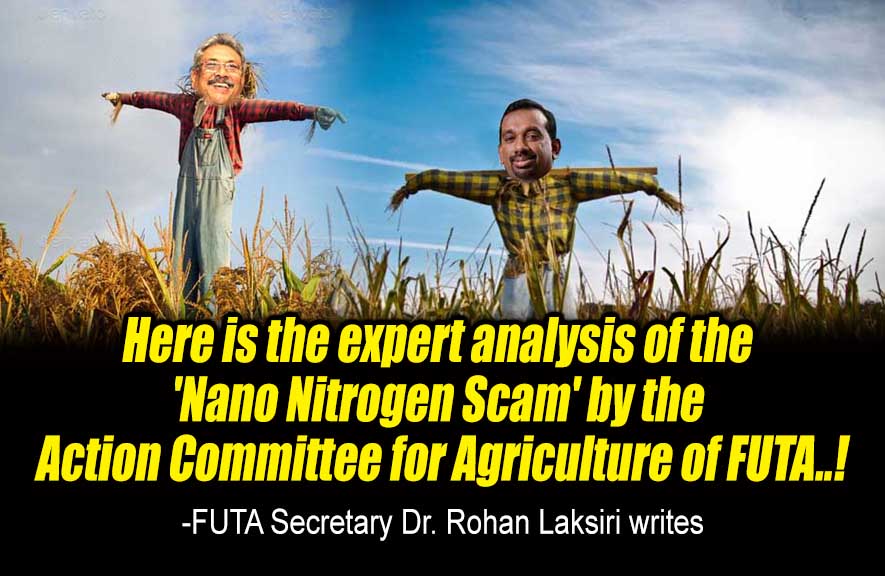-FUTA Secretary Dr. Rohan Laksiri writes

(Lanka-e-News -23.Oct.2021, 3.15 PM) The government of Sri Lanka recently imported liquid Nano-Nitrogen fertilizer from Indian Farmers Fertilizer Cooperative Ltd. (IFFCO). From an initial order of 3.1 million liters, 45,000 liters (90,000 bottles, each carrying 500 ml) have been airlifted on 19th October 2021 to Sri Lanka. We have learned that there are many misconceptions being publicized in the mass media on this Nano-Nitrogen fertilizer. As a concerned group of agricultural professionals in the country, academics attached to the Agriculture and Technology Faculties of State Universities in Sri Lanka, we wish to provide correct scientific facts about the imported fertilizer and express our views on this matter as follows.
The Nano-Nitrogen fertilizer of IFFCO is a urea-based formulation where urea is coated with polymers to make nano-size particles. Therefore, this fertilizer is a synthetic chemical fertilizer, and not an organic fertilizer. The Nano-Nitrogen fertilizer is recommended to apply as a foliar spray and said to contain 4% Nitrogen. This is rather a new product, which has very recently (2021 March) received approval for large scale production from the Ministry of Agriculture of India. Anyhow, nano-fertilizers are not accepted in organic agriculture in Sri Lanka as indicated in the standard of requirements for organic agriculture (SLS1324:2018).
In media briefings conducted by the Ministry of Agriculture, we learned that three applications of 2.5 L of this fertilizer at a time (i.e. 7.5 L in total) is adequate to provide required nutrients for the cultivation of one hectare of paddy crop. When applied at this rate, Nano-Nitrogen fertilizer would provide only 300 g of Nitrogen per one hectare. In general, nearly 105 kg of nitrogen is taken up by the paddy crop yielding 4-5 tons of grains per hectare. Accordingly, Nano-Nitrogen fertilizer should be applied at a rate of 1,250 L per hectare if it is the only source of nitrogen added to the crop, which is an impossible task to be realized within a cropping season.
In their official website, IFFCO has indicated that this Nano-Nitrogen fertilizer should be applied only as a top dressings along with a reduced rate of urea, while phosphorous and potassium sources are to be supplied in full rate as per the recommendations. All research reports on this liquid fertilizer have recommended using this fertilizer to fulfil only partial requirements of Nitrogen for crops and often used with 50% recommended dose of urea. Therefore, Nano-Nitrogen is more appropriate to be viewed as a supplementary source of Nitrogen than a major nutrient source.
Spraying liquid fertilizer may not be practical for some crops unless the farmers have access to drone technology. This is because spraying large areas and taller crops such as maize and sugarcane is not practical with commonly used spray tanks. Moreover, the effectiveness of these foliar fertilizers depends on the ground-cover by leaf area, weather conditions and application technology. Therefore, it is a necessity to provide clear guidance to the farmers on correct application procedures.
In this context there is a serious question as to what should be recommended to the farmers in Sri Lanka, as the sources of nitrogen, phosphorus and potassium nutrients are limited in the market with the recent ban imposed on importing synthetic ‘chemical’ fertilizer. It is important to note that the benefit of Nano-Nitrogen cannot be realized when the crop suffers from nutrient imbalances. The Nano-fertilizer is applied at a much lower rate than regular urea fertilizer application mainly because it is a foliar spray. Applying the Nano-Nitrogen fertilizer at high concentrations, in the absence of soil application of Nitrogen fertilizer such as urea, could damage leaves. Therefore, the available option would be to have repeated application of Nano-Nitrogen fertilizer at a lower dosage.
It should be noted that nano-fertilizers are more expensive than regular nitrogen fertilizers. Thus, considering the cost of the fertilizer and labor cost for application, the use of foliar fertilizers in a crop like paddy is expensive and will increase the cost of production.
Any fertilizer imported to the country needs to be tested following the accepted protocols prior to giving approval for importation and after the shipment has arrived in order to assure quality and to avoid any negative impacts. Sri Lanka does not have developed SLS standards for nano-fertilizers, yet. These standards should be developed to assure quality of the product free of biurate-like toxic substances. Besides, recommendations should not be made in an ad-hoc manner without conducting any field investigations.
Furthermore, in the eco-friendly / green agriculture concept, much attention is given to improve and regenerate soil fertility. However, foliar application of fertilizers will not contribute to enhancing soil fertility.
Therefore, while failing to achieve higher crop yields, it is highly unlikely that the expensive Nano-Fertilizer we have imported will help in realizing the objectives of green-agriculture.
General Secretary
Federation of University Teachers' Associations (FUTA).
---------------------------
by (2021-10-23 09:52:02)
Leave a Reply